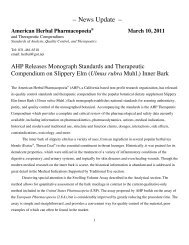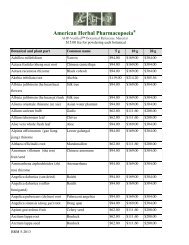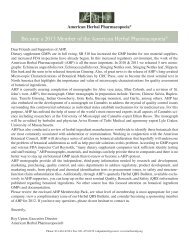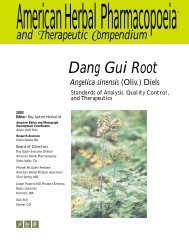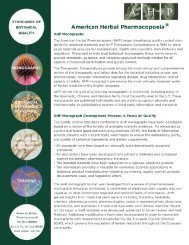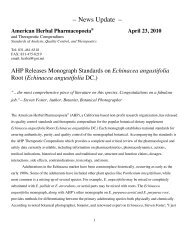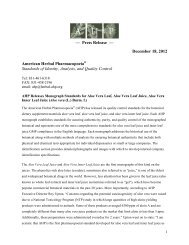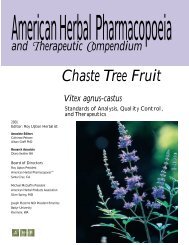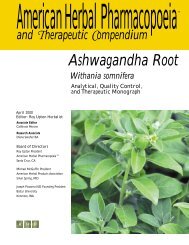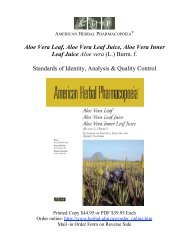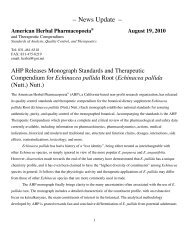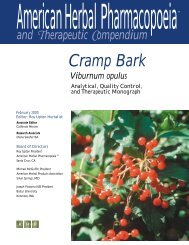alerian oot - American Herbal Pharmacopoeia
alerian oot - American Herbal Pharmacopoeia
alerian oot - American Herbal Pharmacopoeia
Create successful ePaper yourself
Turn your PDF publications into a flip-book with our unique Google optimized e-Paper software.
C OMMERCIAL S OURCES & HANDLING<br />
V<strong>alerian</strong> is cultivated in Britain, Belgium, Eastern Europe, France, Germany,<br />
Holland, Japan, the Netherlands, North America, and Russia (Evans 1996;<br />
Steinegger and Hänsel 1992). The majority of standardized extract products and<br />
crude cut and sifted material on the domestic market are prepared from European<br />
supplies. A large number of liquid extracts are prepared from domestically cultivated<br />
material. Many species other than V. officinalis are reported to be traded as medicinal<br />
v<strong>alerian</strong>. These include V. edulis Nutt. ex Torr. & A. Gray, V. coreana Briq.k, V.<br />
stubendorfi Kreyer ex Kom., V. amurensis P. Smirn. ex Kom., V. hardwickii Wall., V.<br />
exaltata Mikan, and V. wallichi DC. syn. V. jatamansi Jones* (Leung and Foster<br />
1996; Steinegger and Hänsel 1992). The most frequently used North <strong>American</strong><br />
species include V. sitchensis Bong and V. edulis Nutt.* = V. edulis Nutt. ex Torr. &<br />
Gray ssp. procera (Kunth). Other species reported to be used locally include V. arizonica<br />
Gray, V. capitata Pall ex Link., V. diocia L., and V. scouleri Rydb. Detailed<br />
chemical analyses of most <strong>American</strong> species are lacking. A limited number of assays<br />
of material cultivated in the Pacific Northwest show varying levels of essential oil<br />
ranging from 0.4% to 1.3%. Valerenic acid and valepotriates have been found to be<br />
present in fresh and dry samples of V. sitchensis Bong (Anonymous 1996; Förster and<br />
others 1984). V. sitchensis Bong exhibits a strong pungency when fresh.<br />
High quality material is reported to contain from 1.0% to 1.5% essential oil, ≥<br />
30% extractable matter, and ≥ 0.5% valerenic acid (Bos 1997).<br />
* V. wallichi DC. and V. edulis Nutt. reportedly are lacking in valerenic acid and its derivatives (Bos 1997).<br />
Collection<br />
The majority of v<strong>alerian</strong> in trade comes from cultivated material. Harvest times will<br />
vary geographically. The composition of the essential oil varies greatly among different<br />
populations of the same subspecies (Corsi and others 1984) and even between the<br />
same population of plants from year to year (Hazelhoff and others 1979). Essential oil<br />
content also varies with genotypes, harvest times, growing conditions, age of r<strong>oot</strong>, drying<br />
techniques, and method of analysis. It has been reported that v<strong>alerian</strong> harvested<br />
in higher elevations, grown in dryer regions, or those cultivated in phosphate-rich soil<br />
yields relatively high levels of essential oil (Bos and others 1998a).<br />
Older literature reports that v<strong>alerian</strong> should be harvested in the fall, between<br />
August and September, preferably in the second year of growth (Violon and others<br />
1983; Youngken 1930). Analyses of material cultivated in the Netherlands report that<br />
the majority of constituents, including the essential oil and valerenic acid, was highest<br />
in r<strong>oot</strong>s harvested in the first year of growth with essential oil being highest in<br />
September and November (1.2% to 2.1%). The next highest level of essential oil was<br />
reported for material harvested in March (0.9% to 1.6%). Valerenic acid and its derivatives<br />
were found to be highest in February and March (0.7% to 0.9%) followed by<br />
material harvested in September (0.5% to 0.7%) and then in January (0.3% to 0.4%).<br />
Figure 10 Microscopic characteristics of V<strong>alerian</strong>a officinalis<br />
1. Piliferous layer showing cicatrices and attached r<strong>oot</strong> hair.<br />
2. Sclereids from rhizome.<br />
3. Sclereids from base of stem.<br />
4. Parenchyma.<br />
5. Starch grains.<br />
6. Fragment of vessels.<br />
7. Tegumentary tissue showing brown contents.<br />
8. Fibers from stem base.<br />
<strong>American</strong> <strong>Herbal</strong> <strong>Pharmacopoeia</strong> • V<strong>alerian</strong> R<strong>oot</strong> • April 1999 Page 5



